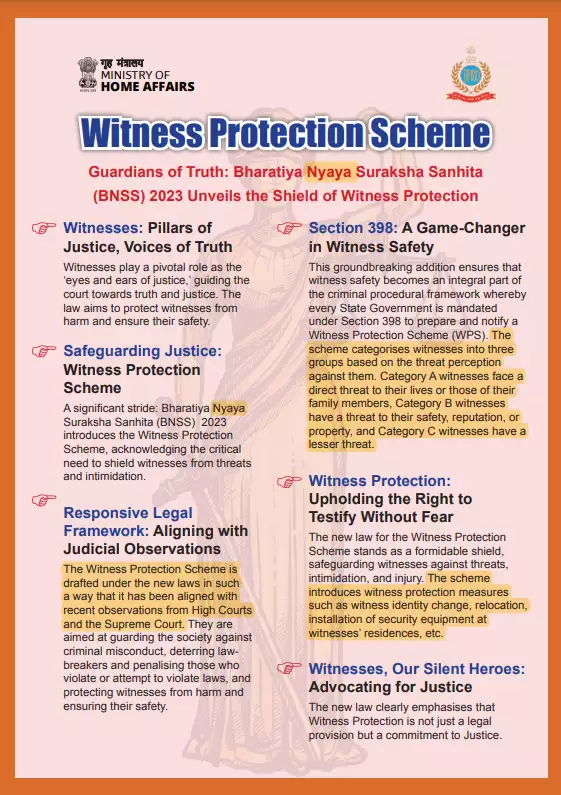The Supreme Court has raised significant concerns regarding the implementation of the Witness Protection Scheme (WPS), 2018, highlighting the poor conditions faced by witnesses in the legal system.
Key Highlights:
- Importance of Witnesses:
- Witnesses are crucial for judicial processes, especially in criminal trials.
- The Supreme Court emphasized that witnesses serve as “the eyes and ears of justice.”
- Concerns Raised by the Court:
- The court noted a lack of effective implementation of the WPS, 2018.
- It underscored the need for better protection measures for witnesses, as their safety is vital for a fair legal process.
About the Witness Protection Scheme (WPS), 2018:
- Objective: The primary aim of the WPS, 2018 is to safeguard witnesses based on threat assessments, ensuring their safety during legal proceedings.
Protection Measures: Protection can include-
- Change of identity
- Relocation of witnesses
Threat Categories:
- The scheme provides protection based on the level of threat faced by witnesses-
- Category A: Life-threatening situations for the witness or their family.
- Category B: Threats to safety, reputation, or property.
- Category C: Moderate threats.
State Witness Protection Fund:
- The scheme includes the establishment of a State Witness Protection Fund.
- States will allocate annual budgets for this fund and can accept donations from philanthropic organizations and corporate entities.
- This fund is managed by the Department/Ministry of Home under the respective State or Union Territory government.
Background of Witness Protection Scheme
- The WPS was developed by the Centre in 2018 with inputs from various stakeholders, including states, National Legal Services Authorities, civil society, High Courts, and police personnel.
- The aim of the scheme is to ensure that the investigation, prosecution, and trial of criminal offenses are not hindered due to witness intimidation.
Historical Context:
- The first reference to witness protection in India was made in the 14th Law Commission Report in 1958.
- Subsequent reports (154th, 178th, and 198th) also recommended the establishment of a witness protection mechanism.
- The Malimath Committee Report advocated for a robust witness protection system and highlighted the courts’ role in protecting witnesses during cross-examination.
Reasons for Witness Hostility:
- The Supreme Court identified several factors contributing to witnesses turning hostile:
- Threats and Intimidation: Direct threats from the accused or their associates.
- Inducements: Financial or other incentives offered to witnesses.
- Use of Muscle Power: Coercion through physical intimidation.
- Stock Witnesses: Fabricated testimonies from individuals favoring the prosecution.
- Protracted Trials: Lengthy legal processes that discourage witnesses.
- Hassles During Investigation: Difficulties faced by witnesses during legal proceedings.
- Lack of Legislation: Absence of clear laws addressing witness hostility.
Supreme Court Judgement:
- The court ruled that the right of witnesses to testify freely is encompassed in Article 21 (Right to Life) of the Constitution.
- It stated that the WPS would be enforceable under Articles 141/142 until appropriate legislative measures are enacted.
- The Supreme Court mandated all states and Union Territories to establish vulnerable witness deposition complexes by the end of 2019 to ensure witnesses and accused do not encounter each other during trials.
Ref: Source
| UPSC IAS Preparation Resources | |
| Current Affairs Analysis | Topperspedia |
| GS Shots | Simply Explained |
| Daily Flash Cards | Daily Quiz |
Frequently Asked Question:
What is the objective of the Witness Protection Scheme 2018?
The scheme aims to safeguard witnesses during legal proceedings by providing protection based on threat assessments.
What categories of threat are identified in the Witness Protection Scheme?
The scheme categorizes threats into three levels: Category A (life-threatening), Category B (safety, reputation, or property risks), and Category C (moderate threats).
What protection measures are available under the WPS 2018?
Protection measures include identity changes, relocation, and securing witnesses from threats.
Why has the Supreme Court raised concerns about the WPS 2018?
The Court highlighted the ineffective implementation of the scheme and stressed the need for better protection of witnesses.
What role does the State Witness Protection Fund play?
It provides financial resources to safeguard witnesses, supported by state budgets and donations from philanthropic organizations.



